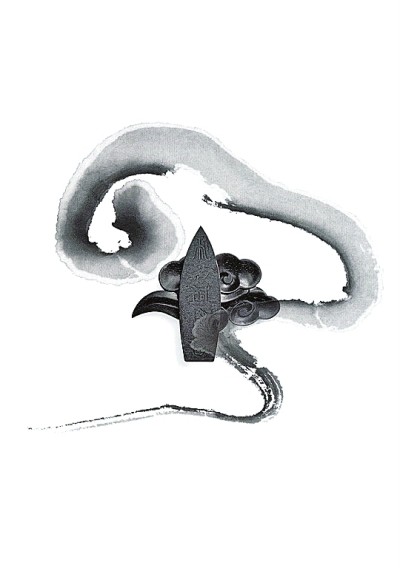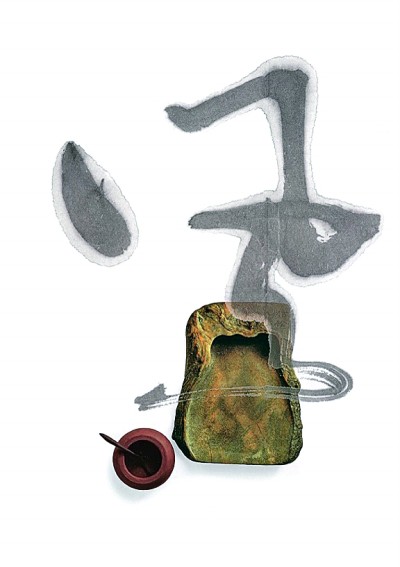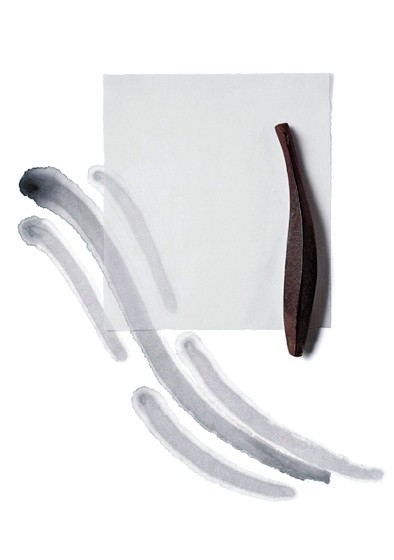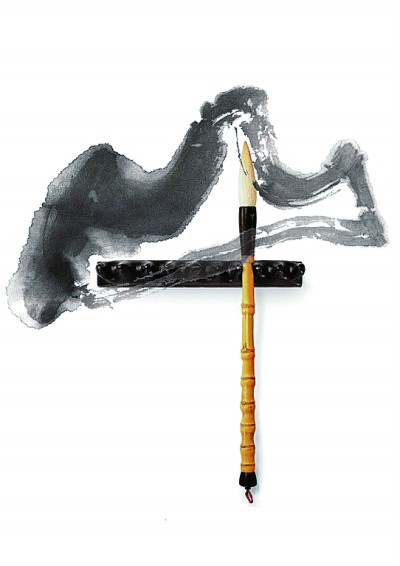Author: Wang Rui (Professor of Chongqing University of Posts and Telecommunications Branch Center, Chongqing Research Center for Theoretical System of Socialism with Chinese Characteristics)
Traditional ink painting and Chinese characters are in harmony. In modern Chinese character design, refining and using the unique cultural nourishment of ink art has become an important source of inspiration. Both traditional ink painting and Chinese characters use form to express meaning. Chinese characters “feel the heart with the beauty of meaning, the ears with the beauty of sound, and the eyes with the beauty of shape”; traditional ink painting contains techniques such as “calculating white instead of black”, and its accidental and fluid characteristics have become an important medium for pictures. Both traditional ink painting and Chinese characters have the functionality of expression and the aesthetics of visual communication. Both of them carry profound Chinese culture in smooth visual form.
“Chinese Characters” by Jin Taiqiang
Schema and idea from composition to abstraction
Combining traditional ink wash language with modern Chinese character design, it is necessary to follow the language principles of harmony and balance, and to reflect graphics and intentions through basic elements, so as to realize the artistry and aesthetics of the work. Points, lines, and planes are the indispensable basic elements of art. The cultural fusion of traditional ink painting language and modern Chinese character design embodies the exploration of rational beauty and artistic conception beauty under the unique aesthetic taste of point, line and surface. The famous artist Kandinsky once proposed in the interpretation of point, line and surface theory that “hidden structure” is obtained through two methods of “covering” and “interception”. Shading and interception embody the symbolization, ordering, simplification and abstraction of graphics composed of points, lines and surfaces. It can be seen that the combination of points, lines, and surfaces is not only a simple visual picture composition, but also its size, direction, length, shape and other morphological changes, as well as distribution forms such as concentration and dispersion, will present hidden inner tension and abstract ideas.

“Chinese Characters” by Jin Taiqiang
Gu Kaizhi, a painter of the Eastern Jin Dynasty, emphasized the importance of abstract expression with brush and ink; Xie He, a figure painter of the Southern Qi Dynasty, proposed the use of abstract elements of brush and ink to achieve a vivid picture effect when talking about the “six methods” of painting. The abstract form of traditional ink language and the abstract form of modern Chinese character design have similar aesthetic judgment standards, and the spiritual, ideological and connotative content needs to be expressed in a clever way. The integration of the two is a process of composition and re-creation of points, lines, and planes. In addition to realizing the direction and meaning of the text itself, it also reflects the abstract beauty, artistic conception, and sentimental beauty of Chinese character design under the principle of formal beauty.
Perspective and transformation from plane to space
Modern design culture puts forward higher requirements for designers’ aesthetics and innovation. The thinking transformation and perspective extension of Chinese character design from plane to space is an important content to be explored by the design community. Traditional Chinese character design is often the secondary processing of information or the accumulation of simple elements, which is more bound to the paper surface, and it is difficult to get rid of the shackles of the plane. The cultural blending of traditional ink painting language and modern Chinese character design is an attempt and exploration of space design based on following design rules and basic principles of beauty.

“Chinese Characters” by Jin Taiqiang
The perspective and transformation from plane to space breaks the limitations of paper and pen, creating a multi-dimensional space. In this process, designers generally follow three principles: first, the principle of contrast and hierarchy. In the fusion of traditional ink language and modern Chinese character design, use occlusion techniques and perspective rules to form front and rear spatial relationships. The former is solid and the latter is virtual. The selection and distribution of elements must have a sense of hierarchy and a primary and secondary relationship; at the same time, the elements must be coordinated. Consistent, create a harmonious space atmosphere. Second, the principle of unity and balance of constituent elements. Make full use of the arrangement rhythm, shape change, size change, harmonious combination, etc. among elements to make the constituent elements three-dimensional, divide the space, and give the audience a multi-dimensional space experience. Third, from the principles of life. Art creation comes from life. Different experiences and aesthetic feelings from life are integrated into the design of Chinese characters, which can create the beauty of order, enrich the visual space, and resonate with the audience’s psychology.
Aesthetics and emotion from static to dynamic
The abstracted dots and their composition with lines and surfaces often create static and dynamic states in the precipitated ink. The use of cadenced brushwork and interesting and vivid brushwork often presents dynamic visual effects on a static plane, and the content of information and mood conveyed often echoes the state of mind of the recipient. In ancient China, artists often used the method of “seeking change in stillness and unity in change” to create the artistic conception of “image outside the painting”. Yang Quan in the Western Jin Dynasty emphasized in “Cursive Script Fu” that characters change due to “potential”, and “potential” contains the state of movement; in Yan Zhenqing’s “Liu Zhongshi Tie” in Tang Dynasty, the last stroke of the word “er” takes the momentum vertically, and it flows thousands of miles; The “point” in Huang Tingjian’s “Zhushangzuotie” in the Northern Song Dynasty looks like a heavy object falling.

“Chinese Characters” by Jin Taiqiang
Recently, the Chinese character design works of Chinese modern designer Jin Taiqiang are quite representative. Using traditional ink painting language, he has created a large number of classic works with national characteristics. For example, his representative work “Nine Nine Returns to One” uses two ink lines to write two “9” characters, which are combined to form the “Hui” character. The shape of the character “Hui” is like the ripples of the lotus petals on the water, implying the return of Macao to the motherland. For another example, the work “Chinese Characters” uses the ink language of hardness and softness to create artistic conceptions full of life and movement: “Mountain” stands tall, “Cloud” floats over, “Wind” blows freely, and “Water” is gentle. flow.
On the whole, there are several ways to realize the presentation from static brushwork to dynamic aesthetics and emotion: First, “blank” processing, coexistence of “positive shape” and “negative shape”. Appropriate blank processing can win the truth by using the virtual, such as euphemistic and implicit narration, adding interest, creating artistic conception, and attracting people’s reverie. Second, “dot” is a dynamic visual intervention as a highly single abstract element. In font design, the expressiveness and extensibility of “dot” are particularly prominent. The cultural blending context of traditional ink painting language and modern Chinese character design gives “dot” sufficient space for expression. “Dots” can break free from the shackles of words to reflect the order of movement alone, and can also be combined with other “dots” to form a dynamic effect that matches the rhythm of the rules. Third, vermilion as a transmission of spiritual elements. Incorporating vermilion into the ink-colored Chinese characters adds a bit of color spirituality, conveying information like life.
Traditional ink painting is integrated into the design of modern Chinese characters with its smooth visual form and profound humanistic spirit, forming a fusion and innovation of co-generation and re-engineering. In this way, people’s abstract generalizations and creative emotions about life and nature can be injected and infiltrated into Chinese characters, forming a Chinese character art with profound cultural heritage and unique vivid beauty. Therefore, the design of modern Chinese characters radiates new vitality.
“Guangming Daily” (version 05, June 4, 2023)
[
责编:袁晴 ]
